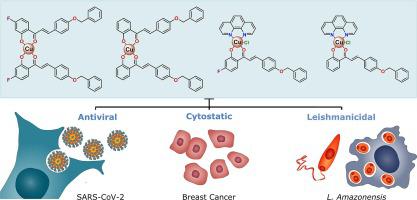Inorganica Chimica Acta Pub Date : 2023-10-11 , DOI: 10.1016/j.ica.2023.121806 Laiane dos Santos Oliveira , Pedro Henrique de Souza Guarda , Letícia Bazilio Rosa , Gustavo Clauss Rodrigues , Daniele Daiane Affonso , João Ernesto de Carvalho , Igor Andrade Santos , Mark Harris , Douglas Hideki Nakahata , José Ricardo Sabino , Danilo Ciccone Miguel , Ana Lucia Tasca Gois Ruiz , Ana Carolina Gomes Jardim , Camilla Abbehausen

|
Chalcones are chemical precursors of flavonoids and exhibit a variety of biological properties, including anti-cancer, anti-inflammatory, and anti-malarial activities. According to the literature, different transition metal complexes of chalcones exhibit antitumor and antibacterial properties. Herein we report the synthesis, characterization, and the in vitro evaluation of antileishmanial, antiproliferative, and antiviral activities of novel copper(II)-2′-hydroxy-4-benzyloxychalcone complexes. Two of the complexes (1 and 2) had the formula [Cu(L)2], and the other two (3 and 4) were characterized as [Cu(L)(phen)Cl], where L is the deprotonated form of the 2′-hydroxy-4-benzyloxychalcones (HL1, is a fluorine substituted analog of HL2) and phen is 1,10- phenanthroline. Structures resolved by single-crystal X-ray diffraction showed that complexes 3 and 4 had a distorted square pyramid geometry, with chloride at the apical position. The stability of the complexes in dimethyl sulfoxide showed a significant variation. A wide range of ligand exchange kinetics was observed in the solution, influenced by chalcone fluorination and the presence of phenanthroline. Potential pharmacological applications were evaluated using in vitro assays for anti-proliferative, leishmanicidal, and antiviral activities. Complexes 1 and 3 showed cytostatic effects against the human breast tumor cell line (MCF-7, GI50 = 4.6 and 1.0 µM, respectively) that could be attributed to the free ligand HL1 (MCF-7, GI50 = 1.16 µM). Moreover, complex 1 showed higher selectivity to MCF-7 cells in comparison to murine immortalized 3T3 cells (GI50 > 100 µM). Complex 2 was inactive and toxic while complex 4 showed an unspecific cytostatic effect. Despite a weak leishmanicidal activity, at 25 µM, complex 3 inhibited (85,1 %) the SARS-CoV-2 replication at 2 µM. As complex 4 also showed good antiviral activity against SARS-CoV-2 (84,7 %), the antiviral activity seems to be related to copper(II)-phenanthroline fragment. This work demonstrates how simple changes in the structure of the ligand affect ligand exchange reactions and, consequently biological activity. It also expands the biological applications of Cu(II) chalcone complexes.
中文翻译:

探索铜(II)与2′-羟基-4-苄氧基查尔酮类似物的配位及其潜在的药理学应用
查尔酮是类黄酮的化学前体,具有多种生物学特性,包括抗癌、抗炎和抗疟疾活性。根据文献,查耳酮的不同过渡金属配合物表现出抗肿瘤和抗菌特性。在此,我们报告了新型铜(II)-2'-羟基-4-苄氧基查耳酮复合物的合成、表征以及抗利什曼尼、抗增殖和抗病毒活性的体外评估。其中两个配合物(1和2)的化学式为 [Cu(L) 2 ],另外两个(3和4)的特征为 [Cu(L)(phen)Cl],其中 L 是2'-羟基-4-苄氧基查耳酮(HL 1是HL 2的氟取代类似物),phen 是 1,10-菲咯啉。通过单晶 X 射线衍射解析的结构表明,配合物3和4具有扭曲的四角锥几何形状,氯位于顶端位置。配合物在二甲亚砜中的稳定性表现出显着的变化。在溶液中观察到各种配体交换动力学,受查耳酮氟化和菲咯啉存在的影响。使用抗增殖、杀利什曼病和抗病毒活性的体外测定来评估潜在的药理学应用。复合物1和3对人乳腺肿瘤细胞系(分别为 MCF-7、GI 50 = 4.6 和 1.0 µM)显示出细胞抑制作用, 这可能归因于游离配体HL 1(MCF-7、GI 50 = 1.16 µM) 。此外,与小鼠永生化 3T3 细胞相比,复合物1对 MCF-7 细胞表现出更高的选择性 (GI 50 > 100 µM)。复合物2没有活性且有毒,而复合物4显示出非特异性细胞抑制作用。尽管复合物3在 25 µM 时杀利什曼病活性较弱,但在 2 µM 时可抑制 (85.1%) SARS-CoV-2 复制。由于复合物4也对 SARS-CoV-2 显示出良好的抗病毒活性(84.7%),因此抗病毒活性似乎与铜 (II)-菲咯啉片段有关。这项工作证明了配体结构的简单变化如何影响配体交换反应,从而影响生物活性。它还扩展了 Cu(II) 查尔酮络合物的生物应用。































 京公网安备 11010802027423号
京公网安备 11010802027423号